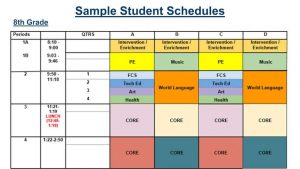Why Block Scheduling is a Horrible Idea

February 13, 2020
Many districts and schools have switched to a block schedule while others have waited to do so. While some stand by the block schedule, many others oppose the new type of schooling, and their voices do not deserve to be silenced by the Board of Education – especially since there are multiple reasons that their concerns are valid.
First off, one common perception of the block schedule is that we get more time in our classes. This may seem true at first glance because the class periods are longer, but don’t be fooled, you only have a given class every other day. Moreover, you are in each class for less amount of time cumulatively throughout the year. It’s just common sense- you are adding one more class to the students’ schedule, but keeping the length of the school day and the school year the same. So if the focus is giving students more class time, why use this type of schedule if it actually decreases class time? This will also put pressure on achieving the curriculum. As it is now, AITE sometimes doesn’t get through the entire curriculum, often requiring the district to excuse entire sections of the district-wide finals. AP scores might go down as well.
Another focus of the block schedule is that it allows for more students to graduate because you have more opportunities to take classes. However, relaxing the graduation requirements is not what we should be doing. For the current seniors, the class of 2020, you only need 20 credits to graduate. If you take 7 classes a year for four years, you have 28 chances to get credit. That means you can fail eight classes, and still graduate. For the current sophomores and freshmen, 25 credits are needed to graduate. With this level of flexibility, you can fail three classes or take three study halls and still graduate. If we went to an eight-period schedule, you would need 25 credits out of a potential 32. The focus for our schools shouldn’t be to make it easier to graduate, rather it should be to raise the bar. Does allowing students to fail nearly two classes a year prepare them for college and the real world? As it is now, less than a third of our students are “college-ready,” meaning they have higher than 1050 on the SAT.
In addition, a frequently mentioned focus of the block schedule is a “WIN” (what I need) period. Each freshman and sophomore is required to take this WIN period, which is a class period where you can get specialized help. A student can get help from the teacher of their WIN period or can go to another teacher. Supporters of the block schedule are quite dependent on the success of this period. However, in all honesty, a WIN period is simply a glorified study hall, and if the current study hall system is broken, what makes people think a WIN period will truly be a win.
Block scheduling will also mean hiring additional teachers and paying current teachers more for teaching a sixth class as opposed to five. The estimated cost of paying teachers more and hiring 40 combined teachers at the two public high schools is over $5 million. This means cutbacks somewhere else from our already hurting school budget.
Class sizes under this system will increase too. In this case, an increase in general class sizes will most negatively impact the areas of the school that thrive with small class sizes – typically, groups like English learners and special education students.
As I spoke to teachers and students to make sense of the situation, and to clarify why we are even thinking of changing our schedule, the most popular response was “because everyone else is doing it.” However, simply because other towns are making the change doesn’t mean we need to as well. If the perks of Block Scheduling are so beneficial and obvious, then why didn’t we move to this years ago? Why wasn’t Stamford Public Schools the pioneer to move toward Block Scheduling?
Well, the reason we weren’t is that the benefits are not so obvious; rather, we are influenced and pressured by surrounding school districts. This should not be a reason to change our schedule. The last time we adopted a program due to influence from other schools was when we added Connection Time, which has not been successful at Stamford High. Why succumb to the propaganda of the state and move to a block schedule? There is no need to fix a system that is not already broken. Besides, there is a multitude of other issues that need tackling before we start with this.
I am a senior at Stamford High School and will be graduating in June. Whether or not we make the change to a block schedule doesn’t even affect me. I clearly did not raise these points because of personal distaste long class periods. I raised them to spread awareness for future students and parents. If the points in this article either strengthened your opposition to the potential scheduling or if this was the first time you heard of it, but agree with the points, please, on behalf of the future students, contact the Board of Education. The BOE shouldn’t be the deciding factor in moving to this schedule. The teachers and students, who are impacted the most by the decision, should be the people deciding. There are many students and plenty of teachers who feel the same way you do, but let’s be real – the Board of Education may not listen to the suggestions of a teacher, but they surely will listen to parents.





Christopher • Nov 16, 2023 at 12:40 pm
How would courses like Weight Training or Sport Courses be effected by this?
julie • Mar 7, 2022 at 12:26 pm
this article is very true